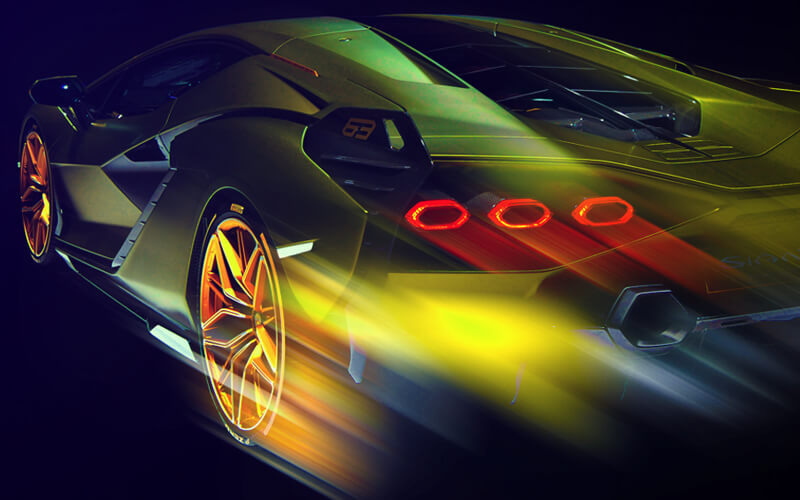
While supercapacitors are fundamentally different from traditional (dielectric) capacitors, at the risk of oversimplification, a supercapacitor is simply a larger capacitor with bigger electrode plates and less distance between them, allowing for a greater charge to be stored in the form of electrical potential energy.
Supercapacitors have greater energy density than common capacitors, but less energy density than batteries – along with almost instantaneous charging and discharging. With the supercapacitor’s low internal resistance, these devices can fully charge within a few seconds. In contrast, a secondary battery cell can take from ten minutes to several hours to fully charge. Moreover, there is no theoretical limit to a supercapacitor’s lifecycle, whereas a lithium-ion secondary cell has a finite lifetime of about 500 cycles.
Supercaps’ Sweet Spot: Hybrid Powertrains
Supercapacitors have traditionally been used for automotive applications that provide bursts of power during short-duration events, such as acceleration, braking and cold starting. Hybrid vehicles completely turn off the engine when they come to a stop, then start with energy from supercapacitors. While a vehicle’s voltage rail can suffer dips, such as during engine cranking in stop-start operation, a supercapacitor can support the voltage rail and prevent interruptions to vehicle electronics, such as the GPS and radio.
This technology fits perfectly into hybrid powertrains. A good solution is to couple the battery with a supercapacitor. In this design, the supercapacitor can provide the excess energy required when the battery fails to do so. Supercapacitors are used to rapidly charge the power supplies in hybrid buses, providing cranking power and voltage stabilization in start/stop systems. They harvest power from regenerative braking systems and release power to help hybrid buses accelerate. Similarly, they can back up and generate peak power for key automotive applications.
The fast movement of charge in supercapacitors is due to very low internal electrical resistance. This means they can be charged and discharged at high specific current values that may be over 100 times that of batteries, without damaging the unit.
Supercapacitors possess an unusually high power and energy density when compared with traditional capacitors – typically several orders of magnitude greater. The time constant of electrostatic capacitors is defined as the time needed to discharge a loaded capacitor. Supercapacitors have a time constant of approximately one second – much higher than that of a typical electrolytic capacitor. So, while the supercapacitor can respond to short pulse power demands, its efficiency is reduced due to the time constraint.
As a result, to avoid overheating, you do not want to expose supercapacitors to a continuous high-frequency ripple current in a hybrid car, which will have an adverse impact on superconductor aging.
Ideally, supercapacitors can last across millions of charge-discharge cycles without performance degradation. That’s because no physical or chemical changes occur when a charge is stored within them. And, because supercapacitors function well in temperatures as low as –40 degrees C, they can give EVs a boost in cold weather when batteries are at their worst.
Recent Developments in Supercapacitors
Supercapacitors are useful for maintaining the main power system’s real-time clock or volatile memory when it is removed, such as during a power failure or when the main power system’s battery has been removed for replacement. The supercapacitor’s benign open-circuit failure mode contrasts with typical short-circuit battery failures that may result in outgassing or ignition.
KEMET’s new supercapacitors for automotive electronics, the FMD and FU0H series, are qualified to an automotive testing protocol. They deliver 1,000 hours at 85°C/85 percent RH-rated voltage and operational temperature ranging from -40 C to 85 C, with the FMD series offering the highest lifetime of up to 4,000 hours. As such, they are well suited for automotive applications needing a main power system backup during a power loss, such as ADAS, autonomous vehicles and central gateway ECUs.
KEMET’s supercapacitors use a proprietary aqueous electrolyte solution that is said to provide high durability against liquid leakage, vibration and thermal shock, thus providing high reliability in harsh environments. Aqueous electrolytes are highly conductive, have a low environmental impact and are non-toxic and non-flammable.
Tesla, which acquired Maxwell Technology in early 2019, has sold its supercapacitor business after two years. UCAP Power, Inc., a developer of supercapacitor-based power solutions, has completed the purchase of the Korean-based business Maxwell Technologies Korea, as well as other related assets including the Maxwell brand. Tesla has confirmed that it has held on to one key Maxwell technology, its dry battery electrode (DBE) process methodology – part of a next-generation 4680 battery cell design the company is working on.
Maxwell Technologies has designed replacements for conventional car batteries with supercapacitors. The supercapacitors are connected across a smaller lead-acid battery. As power demand spikes, such as during acceleration, there is a dip in the overall energy that the battery can provide. Supercapacitors smooth out the peak demands on the battery.
Estonia-based supercapacitor manufacturer Skeleton Technologies says that, within three to five years, its supercapacitors based on patented curved nanoporous graphene material will provide the range for an average daily EV drive, leaving lithium-ion batteries to cover range for longer drives when required, according to entrepreneur and Skeleton Technologies CEO Taavi Madiberk.
As the next step of its strategy, Skeleton aims at merging the long-lifetime, fast-charging supercapacitors and high energy, long-duration battery technology, to allow it to offer a more competitive long range EV battery than any currently on the market or in the development pipeline.
In the rail sector, Skeleton has signed a deal with Škoda to power 114 trams in three cities across Germany, while a contract with Medcom puts the company's technology into Warsaw's new trams. In a given year, a light-rail vehicle might go through 300,000 charging cycles, meaning that in public transportation, supercapacitors have several advantages over batteries – including the fact they also can take advantage of kinetic energy recovered while the vehicle brakes.
Skeleton Technologies also has signed a contract with CAF Power & Automation, a global manufacturer of electric power solutions for the rail industry, to supply supercapacitors in trams powered by CAF’s Onboard Energy Storage Systems (OESS).
Mahle Powertrain and Allotrope Energy have developed a new lithium-carbon battery that its developers claim needs no rare earth metals and can recharge in as little as a minute and a half. The technology features a battery-type anode and a high-capacity electric double layer capacitor (EDLC)-style cathode, separated by an organic electrolyte. It is said to combine the benefits of supercapacitors and traditional lithium-ion batteries with none of the thermal degradation effects experienced by lithium-ion batteries. and stability at high temperatures. As a result, high current delivery and fast charging are possible without external cooling.
Car makers such as Lamborghini are finding that supercapacitors can add some serious extra performance, too. The Lamborghini Sian (pronounced “Shaan”) combines a supercapacitor-powered 34bhp e-motor in conjunction with a V12, for sub 3.0sec 0-62mph performance. The e-motor can take on the strain during low-speed maneuvers such as reversing and parking. The Sián will not be able to travel under electrical power alone.
The massive V12 engine incorporates titanium intake valves and is rated at 785 hp (577 kW) at 8,500 rpm. Combined with the additional 34 hp from the hybrid system, the Sián delivers a total of 819 hp (602 kW), enabling it to reach a top speed of over 350 km/h (217.5 mph).
Follow TTI, Inc. on LinkedIn for more news and market insights.
Statements of fact and opinions expressed in posts by contributors are the responsibility of the authors alone and do not imply an opinion of the officers or the representatives of TTI, Inc. or the TTI Family of Specialists.

